
Quercus douglasii, known as blue oak, is a species of oak endemic to California, common in the Coast Ranges and the foothills of the Sierra Nevada. It is California's most drought-tolerant deciduous oak, and is a dominant species in the blue oak woodland ecosystem. It is occasionally known as mountain oak and iron oak.
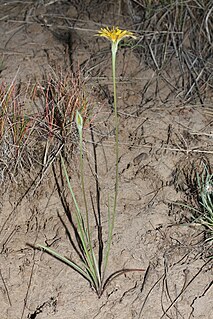
Microseris nutans is a species of flowering plant in the family Asteraceae known by the common name nodding microseris. It is native to western North America, including southwestern Canada and much of the western United States, including the Sierra Nevada in California, where it grows in many types of habitat.

Microseris is a genus of plants in the tribe Cichorieae within the family Asteraceae, native to North America, Australia, and New Zealand. It contains the following species:
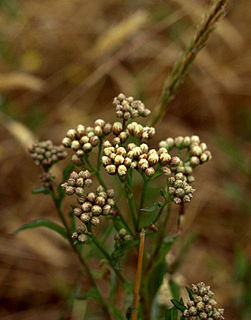
Baccharis glutinosa is a species of flowering plant in the family Asteraceae known by the common names saltmarsh baccharis and Douglas' falsewillow.

Crataegus douglasii is a North American species of hawthorn known by the common names black hawthorn and Douglas' thornapple. It is most abundant in the Pacific Northwest.

Carex douglasii is a species of sedge known by the common name Douglas' sedge.

Coreopsis douglasii is a species of flowering plant in the family Asteraceae known by the common name Douglas' tickseed. It is native to California from Santa Clara County to San Diego County, as well as from Mohave County in Arizona.
Microseris acuminata is a species of flowering plant in the family Asteraceae known by the common name Sierra foothill silverpuffs. It is native to the Central Valley of California and the mountain ranges, including the Sierra Nevada, surrounding it. There is a disjunct occurrence in Jackson County, Oregon. The plant grows in grassy habitat, woodlands, and sometimes the edges of vernal pools.
Microseris bigelovii is a species of flowering plant in the family Asteraceae known by the common name coastal silverpuffs. It is native to the west coast of North America, where its range extends from the southern tip of Vancouver Island to the northern coast of California.
Microseris campestris is a species of flowering plant in the family Asteraceae known by the common name San Joaquin silverpuffs. It is endemic to California, where it grows in the San Joaquin Valley and adjacent Sierra Nevada foothills, and the central California Coast Ranges. It is a resident of grassland and open slope habitats, sometimes near vernal pools.
Microseris elegans is a species of flowering plant in the family Asteraceae known by the common name elegant silverpuffs. It is native to California and Baja California, where it grows in the valleys, foothills, and coastal mountain ranges. Its habitat includes grassland, sometimes near vernal pools, and especially clay soils.
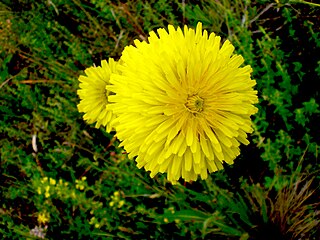
Microseris laciniata is a species of flowering plant in the family Asteraceae known by the common name cutleaf silverpuffs. It is native to the western United States from Washington to northern California and Nevada, where it grows in forest and grassland habitat.
Microseris paludosa is a species of flowering plant in the family Asteraceae known by the common names marsh silverpuffs and marsh microseris. It is endemic to California, where it has a scattered distribution between southern Mendocino and northern San Luis Obispo Counties, mainly near the coast. Its habitat includes coastal scrub and grassland and coniferous forest.

Microseris sylvatica is a species of flowering plant in the family Asteraceae known by the common names sylvan scorzonella and woodland silverpuffs. It is endemic to California, where it has a scattered distribution throughout the central California Coast Ranges and inland mountain ranges, including the Sierra Nevada of the state. Its habitat includes grassland and openings in wooded areas.
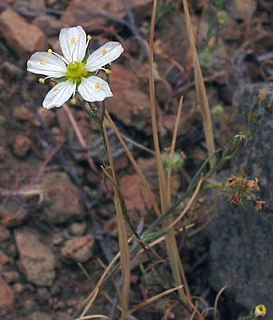
Minuartia douglasii is a species of flowering plant in the family Caryophyllaceae known by the common name Douglas' stitchwort.
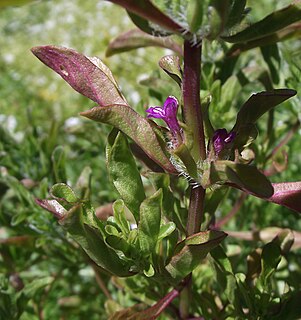
Pogogyne douglasii is a species of flowering plant in the mint family known by the common names Douglas' mesamint and Douglas' beardstyle.
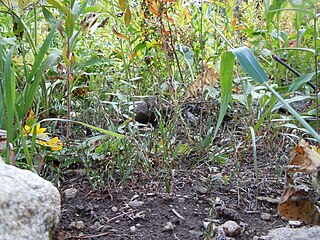
Polygonum douglasii is a species of flowering plant in the knotweed family known by the common name Douglas's knotweed. It is native to much of northern and western North America, where it can be found in many types of habitat, including disturbed areas. It has been found in Canada from British Columbia north to Yukon and east as far as Québec, and in the United States as far south as California, New Mexico, Iowa, and New York.

Silene douglasii is a species of flowering plant in the family Caryophyllaceae known by the common name Douglas's catchfly.
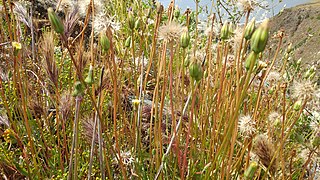
Microseris heterocarpa, known by the common name grassland silverpuffs, is a species of flowering plant in the family Asteraceae.
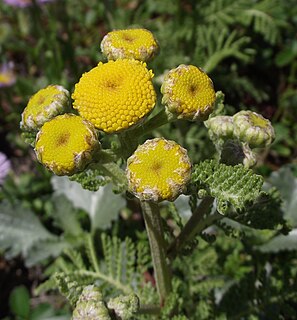
Tanacetum camphoratum is a species of flowering plant in the aster family known by the common names camphor tansy and dune tansy. It is native to the Pacific Coast of North America from British Columbia to California, where it grows in sand dunes and other coastline habitat. This species may be known by the synonym Tanacetum douglasii and is often included in Tanacetum bipinnatum. It is a rhizomatous perennial herb with a thick, low-lying stem up to 25 centimeters long, branching to form a mass of vegetation. It is hairy, glandular, and aromatic, with a camphor scent. The leaves are up to 25 centimeters long and thick but featherlike, divided into many narrow leaflets on each side of the main rachis. Each leaflet in turn has many segments along each side, and the segments are usually divided into several small, knobby segments with folded or curled edges. The inflorescence bears up to 15 flower heads, each about a centimeter wide or slightly wider. Each head contains many yellowish disc florets and many pistillate florets around the edges. The latter may have minute ray florets. The fruit is an achene a few millimeters long which is tipped with a small pappus of toothed scales.














